Beurer BC 81 User Manual
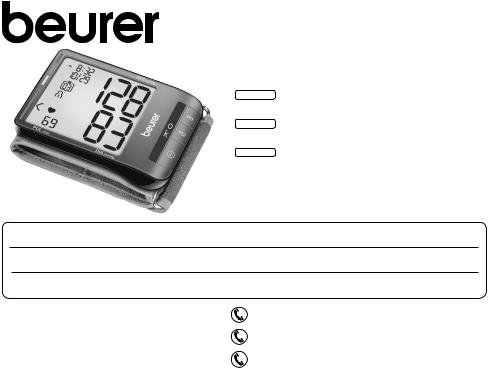
BC 81
ENGLISH |
Wrist Blood Pressure Monitor |
|
|
Instruction manual...................... |
2-32 |
ESPANOL |
Tensiómetro para muñeca |
|
|
Manual de instrucciones.......... |
33-65 |
FRANÇAIS |
Tensiomètre au poignet |
|
|
Mode d‘emploi......................... |
66-100 |
Electromagnetic Compatibility |
|
|
Information............................................... |
101-103 |
|
READ THIS MANUAL COMPLETELY AND CAREFULLY BEFORE USING THIS PRODUCT
Keep this manual in a safe location for future reference
LEA TODO ESTE MANUAL CON ATENCIÓN ANTES DE USAR ESTE PRODUCTO
Conserve este manual en un lugar seguro para consultarlo en el futuro
LISEZ CE MODE D’EMPLOI COMPLÈTEMENT ET ATTENTIVEMENT AVANT D’UTILISER CE PRODUIT
Conservez ce manuel en lieu sûr pour y faire référence ultérieurement
Distributed by/Distribuido por/Distribué par : Beurer North America LP
900 N Federal Hwy, Ste 300
Hallandale Beach, FL 33009
Questions or comments?
Call toll free 1-800-536-0366 or contact info@beurer.com
¿Preguntas o comentarios? Llame gratis al 1-800-536-0366 o póngase en contacto info@beurer.com
Questions ou commentaires? Appeler gratuitement 1-800-536-0366 ou communiquez avec info@beurer.com

ENGLISH
CONTENT
1. IMPORTANT SAFETY NOTES............................ |
2 |
|
2. |
Getting to know your device ............................. |
7 |
3. IMPORTANT SAFETY INSTRUCTIONS............. |
8 |
|
4. |
Parts and Controls........................................... |
12 |
5. |
Preparing for measurement.............................. |
13 |
6. |
Measuring blood pressure............................... |
15 |
1. IMPORTANT SAFETY NOTES
Signs and symbols
The following signs appear in the Safety Section (pages 2, 3, 4, 5, 6, 7, 8) and in this manual on pages 14, 16, 17, 18, 19, 22, 23, 26, 27, 28.
WARNING WARNING indicates a hazardous situation which, if not avoided, could result in death or serious injury.
CAUTION CAUTION indicates a hazardous situation which, if not avoided, may result in minor or moderate injury.
7. |
Displaying and deleting measurements......... |
24 |
|
8. |
Error messages/troubleshooting.................... |
26 |
|
9. |
Care, maintenance and storing the instrument.26 |
||
10. |
FCC/IC Statement.......................................... |
27 |
|
11. |
Technical Specifications................................ |
28 |
|
12. |
Warranty |
......................................................... |
30 |
NOTICE |
NOTICE addresses practices not |
||
|
|
related to personal injury, such as |
|
|
|
product and/or property damage. |
|
READ THIS ENTIRE MANUAL, THE SAFETY SECTION AND ALL INSTRUCTIONS AND WARNINGS COMPLETELY AND CAREFULLY BEFORE USING THIS PRODUCT. FOLLOW ALL SAFETY INSTRUCTIONS AND WARNINGS TO AVOID HAZARDOUS SITUATIONS AND TO MAKE CORRECT USE OF THIS PRODUCT.
2

 WARNING:
WARNING:
•Consult your physician or pharmacist before starting to measure your blood pressure.
•Read and understand all instructions and warnings before using this device.
•Like any oscillometric blood pressure measurement devices, certain medical conditions can affect the measurement accuracy, among others:
–disorder of the cardiac rhythm
–very low blood pressure
–patients in shock
–patients with very low blood perfusion
–diabetes
–vessel anomalities
–people with electrical implants, such as a cardiac pacemaker
–women who are pregnant.
Due to their condition the oscillometric measurement method can produce incorrect readings. This represents a risk for your health, since values may be interpreted incorrectly. Always consult your physician to determine what will be suitable for you.
•This product does not and is not intended to provide a medical diagnosis. Measurements results are for reference only. Self-diagno- sis and treatment, e.g. regarding medication, using measured results represent a risk for your health. Always consult with a licensed physician for determination of appropriate medication and dosage thereof. Follow the instructions of your physician or licensed healthcare provider. If you have or suspect that you have a medical problem, promptly consult your physician. If you have an emergency please call 911 immediately.
•Only a physician or a trained health care professional who is familiar with your medical history is able to accurately interpret your blood pressure measurements. Consult your physician before starting blood pressure monitoring.
•This product is not intended to serve as a substitute for the advice of a physician or medical professional. This product is not intended to substitute for regular medical checkups. Contact your physician for specific information about your blood pressure.
•Please note that technically related measuring tolerances are possible. Please see section “10. Technical Specifications” for details.
3

 WARNING:
WARNING:
•Any cuff related blood pressure measurement in high repetition rates, can lead to severe measurement side effects, e.g.
–any nerve compression with temporary arm/ hand paralysis
–the release of an arterial or venous thrombus, which can cause a life threatening situation.
Please contact your physician about the specific risks of cuff pressure in your specific case.
•The ’irregular heartbeat’ function does not replace a cardiac examination, but may help to detect potential pulse irregularities at an early stage. Always consult your physician to determine what will be suitable for you.
•The ’irregular heartbeat’ function is not designed for diagnosing or treating an arrhythmic disorder. Arrhythmia can only be ascertained by a licensed physician.
•The WHO chart is not intended to replace a medical diagnosis. This chart is only a reference for different classifications of blood pressure.
•If you notice abnormal or suspicious variations in blood pressure measurements, consult your physician immediately.
•Women who underwent a breast or axillar lymph node removal operation should consult a physician or licensed healthcare provider before starting blood pressure measurements.
•Prior to use, you have to ensure that the blood pressure monitor is free of damage. If in doubt, do not use the unit and contact customer service at 1-800-536-0366.
•This device is intended only for personal, non-commercial, adult use in measuring blood pressure and pulse rate. Do not use the product for any other purpose. This product is not intended for use in a hospital, physician’s office, or any other health care facility.
•The unit must be used in accordance to the specified ambient conditions, otherwise the accuracy of readings might be affected. See section “8. Care, maintenance and storing the instrument” and section “10. Technical Specifications” for details.
•Do not wrap the cuff around body parts other than your wrist. Misuse represents a risk to your health.
4
•Please do not share the cuff with other infected persons, to avoid cross infection.
•Use this monitor only on humans.
•This product is not intended for use by or on children, toddlers and infants or on persons who cannot express their consent, e.g. persons with mental disorders or the like. Consult your physician for alternative methods of measuring a child’s blood pressure.
•This product is not a toy. Keep it out of reach of children, toddlers, and infants.
•Keep the product out of the reach of pets.
•Packaging materials are a deadly hazard for children and can cause suffocation. Remove all packaging materials immediately and keep them away from children at all times.
•This product contains small parts that may present a choking hazard to children. Keep the unit and all parts out of reach of children. NEVER LEAVE CHILDREN OR THOSE WHO REQUIRE CLOSE SUPERVISION UNATTENDED WITH THIS DEVICE.
•Keep this product away from children and those who require close supervision, e.g. people with mental disorders. NEVER LEAVE
CHILDREN OR THOSE WHO REQUIRE CLOSE SUPERVISION UNATTENDED WITH THIS DEVICE.
•People with disabilities, activity limitations, or who are physically frail, should be assisted by another person when using this unit.
•Proper cuff size is important for accurate measurements. Only use the device on adults who have the wrist circumference for this instrument. See section “10. Technical Specifications” for suitable wrist circumferences.
•Do not use any cuffs, tubes, parts and accessories other than those explicitly recommended by the manufacturer for use with this product. Parts and accessories not approved for use with the device may cause damage to your health and to the product.
•Electromagnetic interference: Avoid strong electrical or electromagnetic fields in the direct vicinity of the device (e.g. mobile telephones, microwave ovens) while it is in operation, as inaccurate measurements may result. To prevent such interference, use the unit at a sufficient distance from such devices or turn the devices off.
5

•Do not measure your blood pressure while operating a vehicle or in any situation which requires your full attention.
 CAUTION:
CAUTION:
•The device should not be used when your wrist has been wounded/injuried or when a catheter has been inserted. Such use may result in injury.
•Remove any kind of wrist jewelry or the like before taking a measurement. This could cause bruises.
•Do not place the wrist cuff over heavy clothing (e.g. a jacket or sweater sleeve) as the blood pressure monitor will not be able to take a proper measurement and there is an elevated danger of acquiring hematoma or skin marks during the course of the measurement.
•In case the cuff does not stop inflating, interrupt the measurement by pressing the start/ stop button  and open the cuff at once.
and open the cuff at once.
•Do not disassemble the unit, it may result in injuries.
•When applying the blood pressure monitor, make sure there are no wrinkles in the cuff. This could cause bruises.
•Blood pressure measurements can lead to temporary marks on the skin at the site of the cuff placement. This is especially the case in high repetition rates, in hypertonic patients and in patients with weak pulses. In rare cases a mark may persist for a couple of days. Please contact your physician about these specific risks of cuff pressure in your specific case.
•For hygienic reasons the cuff is intended only for the use by one person.
•Prolonged over-inflation (cuff pressure exceeds 300 mmHg or maintained above 15mmHg for longer than 3 minutes) of the bladder may cause ecchymoma of your arm.
NOTICE:
•The blood pressure monitor is made up of precision electronic components. Accuracy of readings and the instrument’s service life depend on careful handling. Protect the unit against hard knocks (e.g. dropping the unit), moisture, water, dirt, dust, chemicals, extreme hot or cold temperatures, major temperature fluctuations, direct exposure to sunlight and heat sources which are too close (e.g. stoves,
6
heating radiators). This may damage the unit. The device must be stored in the specified ambient conditions. Please see section “8. Care, maintenance and storing the instrument” and section “10. Technical Specifications” for details.
•Do not use any aggressive solvents, cleaning agents, detergents or any other strong chemicals to clean the device.
•Never immerse and or spill water or any other liquid onto the monitor or any components, otherwise liquid will enter it and cause damage.
•Do not wash the unit in a washing machine, dish washer or tumble dryer.
•Observe the local regulations for material disposal. Dispose of the device, components and optional accessories according to applicable local regulations. Unlawful disposal may cause environmental pollution.
•Never attempt to repair, open and/or disassemble the unit or adjust it yourself. This may damage the unit and impair the functions. If you need to have the unit repaired, please contact our customer service. Please see warranty for service contact. Before submitting any complaint, first check the batteries and replace them if necessary.
•Changes or modifications to the device will nullify the user warranty.
•Do not drop or insert any object into any opening or hose. This may damage the unit.
•Do not press the buttons with excessive force or with pointed objects.
2. Getting to know your device
SAVE THESE INSTRUCTIONS FOR FUTURE REFERENCE
If the instruction manual is damaged or if you no longer have the instruction manual in your possession, please contact customer service at 1-800-536-0366 or at info@beurer.com.
The wrist blood pressure monitor performs non-in- vasive measurement and monitoring of arterial blood pressure values in human adults. This lets you quickly and easily measure your blood pressure, save the measurements and track changes in the measurements. You are also warned of possible existing cardiac arrhythmia.
The readings are classified according to WHO guidelines and are displayed graphically.
7
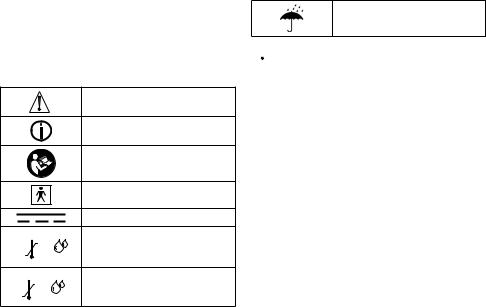
3. IMPORTANT SAFETY
INSTRUCTIONS
Signs and symbols
The following symbols are used in these instructions for use, on the packaging and on the rating plate for the device:
|
|
Attention |
|
|
Note |
|
|
Note on important information |
|
|
Observe the instructions for use |
|
|
Application part, type BF |
|
|
Direct current |
Storage / transport |
Permissible storage temperature |
|
|
70°C |
|
|
(158°F) |
and humidity |
-25°C |
RH 10-93% |
|
(-13°F) |
|
|
Operating conditions |
Permissible operating tempera- |
|
|
40°C |
|
(41°F) |
(104°F) |
ture and humidity |
RH 15-93% |
||
5°C |
|
|
Protect from moisture
 Advice on use
Advice on use
•For consistency, always measure your blood pressure at the same time each day.
•Before each measurement, relax for about five minutes.
•When performing multiple measurements on an individual, wait five minutes between each measurement.
•Do not take a measurement within 30 minutes of eating, drinking, smoking or exercising.
•Repeat the measurement if you are unsure of the results.
•Measurements are for your information only – they are no substitute for a medical examination. Discuss the measurements with your doctor and never base any medical decisions on them (e.g. medicines and their administration).
•Do not use the wrist blood pressure monitor on newborns or patients with pre-eclampsia. Consult a doctor before using the wrist blood pressure monitor during pregnancy.
8

•In the case of restricted circulation on the arm as a result of chronic or acute vascular diseases (including vascular constriction), a wrist measurement can be inaccurate. In this case you should avoid using a wrist blood pressure monitor.
•Cardiovascular diseases may lead to incorrect measurements or affect measurement accuracy. The same also applies to very low blood pressure, diabetes, circulatory disorders and arrhythmias as well as chills or shaking.
•The wrist blood pressure monitor must not be used in connection with a high-frequency surgical unit.
•Only use the device on people who have the specified wrist measurement for the device.
•Please note that when inflating, the functions of the limb in question may be impaired.
•During measurement, blood circulation must not be restricted for an extended period. If the device malfunctions, remove the device from the wrist.
•Avoid any mechanical restriction, compression or bending of the cuff line.
•Do not allow sustained pressure in the cuff or frequent measurements. The resulting restriction of blood flow may cause injury.
•Do not use on an wrist in which the arteries or veins are undergoing medical treatment, e.g. intravascular access or therapy, or an arteriovenous (AV) shunt.
•Do not use if you have had a mastectomy.
•Do not place the cuff over wounds as this may cause further injury.
•The wrist blood pressure monitor can only be operated with batteries.
•As soon as the batteries are empty the blood pressure monitor loses the date and time.
•To conserve batteries, the monitor switches off if no buttons are pressed for three minutes.
•Use this device only as described in these instructions for use. The manufacturer is not liable for damage resulting from improper or careless use.
Instructions for storage and maintenance
•This wrist blood pressure monitor consists of precision electronic components. Measurement accuracy and service life of the device depend on careful handling:
9

–Protect the device from impacts, humidity, dirt, marked temperature fluctuations and direct sunlight.
–Do not drop the device.
–Do not use the device in the vicinity of strong electromagnetic fields and keep it away from radio systems or mobile telephones.
•Remove the batteries if not using the device for a prolonged period.
 Battery Handling and Usage
Battery Handling and Usage
•Keep batteries away from children and pets. Batteries may be harmful if swallowed. Should a child or pet swallow a battery, seek medical assistance immediately.
•Use only the size and type of batteries specified.
•Swallowing batteries can be extremely dangerous. Keep batteries out of the reach of small children. If a battery is swallowed, seek medical attention immediately.
•Use alkaline batteries.
•Be sure to follow the correct polarity when installing the batteries. Reversed batteries may cause damage to the device.
•Do not mix different types of batteries together (e.g. Alkaline and Carbon-zinc or rechargeable batteries) or old batteries with fresh ones. Always replace batteries as a simultaneous set.
•If the batteries in the device are depleted or the device will not be used for a long period of time, remove the batteries to prevent damage or injury from possible battery leakage.
•Do not try to recharge batteries not intended to be recharged; they can overheat and rupture (follow battery manufacturer’s directions.)
•Do not dispose of batteries in fire, batteries may explode or leak.
•Clean the battery contacts and also those of the device prior to battery installation.
•Remove discharged batteries from the product and dispose/recycle in compliance with all applicable laws.
•Swallowing batteries and/or battery fluid can be extremely dangerous. Keep the batteries and the unit out of the reach of children and disabled persons. Should any person swallow a battery and/or battery fluid, please call 911 immediately.
•Batteries should not be charged or reactivated by any other means. The batteries may explode.
10

•Batteries should not be taken apart, thrown in the fire or short circuited. The batteries may explode.
•Should battery fluid leak and come into contact with your eyes or skin immediately rinse with plenty of clean water. Please call 911 immediately.
•If a battery has leaked do not touch the battery fluid. Avoid skin contact (e.g. put on protective gloves) and clean the battery compartment with a dry cloth.
•Batteries can contain toxins that are harmful to the environment. Always dispose of batteries in accordance with applicable local regulations.
•Always use the size and type of battery indicated. The use of other batteries will damage the device.
•Never use different types of batteries, battery brands or batteries with different capacities. This may damage the unit. You should preferably use alkaline batteries.
•Never use rechargeable batteries. This may damage the unit.
•Always replace all batteries at the same time and use batteries of the same type.
•Replace weak batteries before they discharge completely. When 

 appears in the display please change the batteries.
appears in the display please change the batteries.
•Leaking batteries may damage the device. If you do not intend to use the unit for longer periods, remove the batteries from the battery compartment before placing the device in storage.
 Instructions for repairs and disposal
Instructions for repairs and disposal
•Please dispose of product and empty batteries in compliance with all laws applicable in your area. If you have any questions, contact your local solid waste authority.
•Do not open the device. Failure to comply will result in voiding of the warranty.
•Do not repair or adjust the device yourself. Proper operation can no longer be guaranteed in this case.
•Repairs must only be carried out by Customer Services or authorised suppliers. Before making a claim, please check the batteries first and replace them if necessary.
11
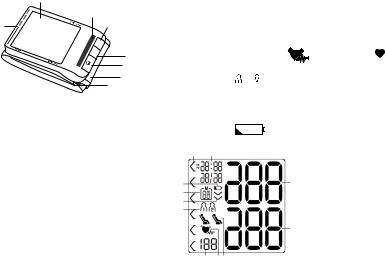
4. Parts and Controls |
|
|
|
Information on the display: |
|
|||||
1. |
Measurement |
2 |
|
|
|
1. |
Measurement classification indicator |
|||
|
classification |
|
|
|
2. |
Time and date |
|
|||
|
|
3 |
|
|
|
|||||
|
indicator |
|
4 |
|
3. |
Systolic pressure |
|
|||
|
1 |
|
|
|
||||||
2. LCD Display |
|
|
4. |
Diastolic pressure |
|
|||||
|
|
|
|
|||||||
3. |
Positioning Indi- |
O |
M1 |
|
5 |
5. |
Resting indicator (symbol is inactive) |
|||
|
cator (heart level) |
k |
|
|
6. |
Irregular heartbeat symbol |
/Pulse symbol |
|||
|
|
|
|
|
|
|
|
|
|
|
4. |
Memory button |
|
|
|
6 |
7. |
Pulse rate |
|
|
|
|
M1 |
|
|
8 |
7 |
8. |
User memory / |
|
||
5. |
Memory button |
|
|
|
9. |
Deflation indicator |
|
|||
|
|
|
|
|
||||||
|
M2 |
|
|
|
|
10. Memory number/memory display average value |
||||
6. |
START/STOP button |
|
|
|
|
(A), morning (AM), evening (PM) |
||||
7. |
Battery Compartment Cover |
|
|
|
11. Battery status |
|
||||
8. |
Wrist cuff 5.3” to 9.1” (13.5 cm to 23 cm) |
|
|
|
1 |
2 |
|
|
||
|
|
|
|
|
|
|
|
|
||
|
|
|
|
|
|
|
11 |
|
|
3 |
|
|
|
|
|
|
|
10 |
|
|
|
|
|
|
|
|
|
|
9 |
|
|
|
|
|
|
|
|
|
|
8 |
|
! |
|
|
|
|
|
|
|
|
|
OK |
|
|
|
|
|
|
|
|
|
|
|
|
4 |
|
|
|
|
|
|
|
|
7 |
6 5 |
|
12
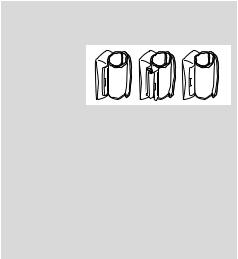
Contents:
-1x BC81 Wrist Blood Pressure Monitor -1x Instruction manual
-1x Quick start guide -2x AAA batteries -1x Storage box
-1x Blood pressure passport
5. Preparing for measurement
Inserting the batteries
• Remove
the battery compart-
ment cover.
• Insert two AAA size
batteries (included), ensuring correct polarity. Do not use rechargeable batteries.
• Reattach the battery compartment cover.
If the low battery icon flashes and E6 appears, replace the batteries.
After inserting the batteries, all LCD Display elements briefly appear and 12h flashes in the display. Set the date and time as described below.
Remove the clear plastic sheet protecting the LCD Display.
13
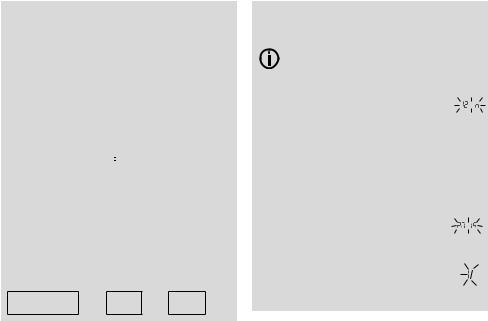
NOTICE:
•Never use different types of batteries, battery brands or batteries with different capacities. This may damage the unit. You should preferably use alkaline batteries.
•Never use rechargeable batteries. This may damage the unit.
•Always replace all batteries at the same time and use batteries of the same type.
•Replace weak batteries before they discharge completely.
•When  and
and 

 appears in the display, please change the batteries.
appears in the display, please change the batteries.
•Leaking batteries may damage the device. If you do not intend to use the unit for longer periods, remove the batteries from the battery compartment before placing the device in storage.
Setting the hour format, date and time
This menu allows you to set the following functions, one after another.
Hour format Date Time
If date and time are not set, you will not be able to save your measured values correctly with a date and time and access them again later.
Press and hold the M1 or M2 memory buttons to scroll values more quickly.
Hour format
• Press and hold the START/STOP button for 5 seconds until “12 h” flashes in the LCD Display.
• Select the desired hour format using
the M1/ M2 memory buttons and confirm with the START/STOP button.
Date
The year flashes in the LCD Display.
• Select the year using the M1/M2 memory buttons and confirm with the START/STOP button.
The month then flashes in the LCD Display.
• Select the minute with the M1/M2 memory buttons and confirm with the START/ STOP button.
14
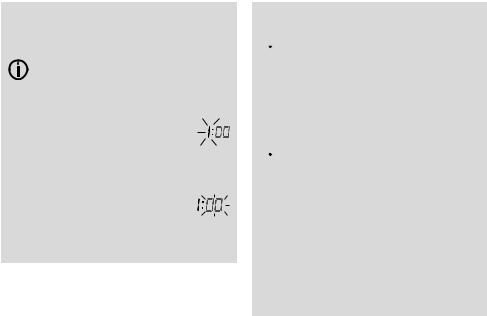
The day flashes in the LCD Display.
•Select the day using the M1/M2 memory buttons and confirm with the START/STOP button.
If the hour format is set to 24 h, the day/
month display order is reversed.
Time
The hour flashes in the LCD Display.
• Select the hour using the M1/M2 memory buttons and confirm with the START/STOP button.
The minutes flash on the display.
• Select the minute with the M1/M2 memory buttons and confirm with the
START/STOP button.
When all data has been set, the device shuts off.
6. Measuring blood pressure
 WARNING:
WARNING:
•Proper cuff size is important for accurate measurements. Only use the device on adults who have the right wrist circumference for this instrument.
This unit includes a wrist blood pressure monitor with a cuff size of 5.3” to 9.1” (13.5 cm to 23 cm ).
 WARNING:
WARNING:
•People with disabilities, activity limitations, or who are physically frail, should be assisted by another person when using this unit.
•Consult your physician or pharmacist before starting to measure your blood pressure.
•Read and understand all instructions and warnings before using this device.
•Like any oscillometric blood pressure measurement devices, certain medical conditions can affect the measurement accuracy, among others:
15

–disorder of the cardiac rhythm
–very low blood pressure
–patients in shock
–patients with very low blood perfusion
–diabetes
–vessel anomalities
–people with electrical implants, such as a cardiac pacemaker
–women who are pregnant.
•Due to their condition the oscillometric measurement method can produce incorrect readings. This represents a risk for your health, since values may be interpreted incorrectly. Always consult your physician to determine what will be suitable for you.
•This product is not intended to serve as a substitute for the advice of a physician or medical professional. This product is not intended to substitute for regular medical checkups. Contact your physician for specific information about your blood pressure.
•Women who underwent a breast or axillar lymph node removal operation should consult a physician or licensed healthcare provider before starting blood pressure measurements.
•Prior to use, you have to ensure that the blood pressure monitor is free of damage. If in doubt, do not use the unit and contact customer service at 1-800-536-0366.
•This device is intended only for personal, non-commercial, adult use in measuring blood pressure and pulse rate. Do not use the product for any other purpose. This product is not intended for use in a hospital, physician’s office, or any other health care facility.
•The unit must be used in accordance to the specified ambient conditions, otherwise the accuracy of readings might be affected. See section “8. Care, maintenance and storing the instrument” and section “10. Technical Specifications” for details.
•Do not wrap the cuff around body parts other than your wrist. Misuse represents a risk to your health.
16

•Use this monitor only on humans.
•This product is not intended for use by or on children, toddlers and infants or on persons who cannot express their consent, e.g. persons with mental disorders or the like. Consult your physician for alternative methods of measuring a child’s blood pressure.
•People with disabilities, activity limitations, or who are physically frail, should be assisted by another person when using this unit.
•Proper cuff size is important for accurate measurements. Only use the instrument on adult persons whose wrist has the right circumference for the instrument. See section “10. Technical Specifications” for suitable wrist circumferences.
•Do not use any cuffs, parts and accessories other than those explicitly recommended by the manufacturer for use with this product. Parts and accessories not approved for use with the device may cause damage to your health and to the product.
•Electromagnetic interference: Avoid strong electrical or electromagnetic fields in the direct vicinity of the device (e.g. mobile telephones, microwave ovens) while it is in operation, as inaccurate measurements may result. To prevent such interference, use the unit at a sufficient distance from such devices or turn the devices off.
•Do not measure your blood pressure while operating a vehicle or in any situation which requires your full attention.
•Any cuff related blood pressure measurement in high repetition rates, can lead to severe measurement side effects, e.g.
–any nerve compression with temporary arm/hand paralysis
–the release of an arterial or venous thrombus, which can cause a life threatening situation.
•Please contact your physician about the specific risks of cuff pressure in your specific case.
17

 CAUTION:
CAUTION:
•The device should not be used when your wrist has been wounded/injuried or when a catheter has been inserted. Such use may result in injury.
•Remove any kind of wrist jewelry or the like before taking a measurement. This could cause bruises.
•Do not place the device over heavy clothing (e.g. a jacket or sweater sleeve) as the blood pressure monitor will not be able to take a proper measurement and there is an elevated danger of acquiring hematoma or skin marks during the course of the measurement.
•In case the cuff does not stop inflating, interrupt the measurement by pressing the start/ stop button and open the cuff at once.
•When applying the wrist cuff, make sure there are no wrinkles in the cuff. This could cause bruises.
•Blood pressure measurements can lead to temporary marks on the skin at the site of the cuff placement. This is especially the case in high repetition rates, in hypertonic patients and in patients with weak pulses. In rare cases a mark may persist for a couple of days. Please contact your physician about these specific risks of cuff pressure in your specific case.
•For hygienic reasons the cuff is intended only for the use by one person.
•It is recommended that the cuff be cleaned after every 200th use.
•It is recommended that the cuff be disinfected twice a week using a cloth that is lightly moistened with ethyl alcohol (75 – 90 %); then allowed to air dry.
•The cuff must be fitted snugly around your wrist, but must not constrict blood flow.
18
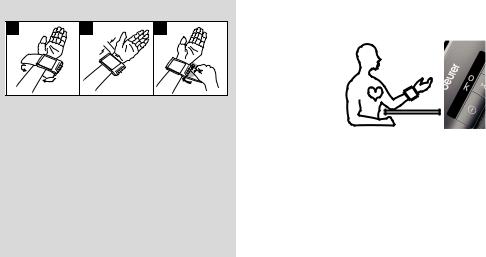
6.1 Attaching the cuff
1 |
2 |
|
|
) |
3 |
|
|
|
(1 |
cm |
|
|
|
.4" |
|
|
|
|
|
|
|
|
|
|
|
0 |
|
|
|
|
M1 |
|
|
|
|
|
kO M2 |
|
|
|
M1 |
|
|
|
|
O M1 |
|
|
|
|
|
kM2 |
kO M2 |
•Remove any clothing or jewelry from your left lower arm. Ensure that blood circulation in the arm is not restricted by tight clothing or similar items.
Place the cuff on the inside of your wrist with your palm facing upwards.
•Fasten the cuff with the hook-and-loop strip so that the upper edge of the device is positioned approx. 0.4” (1 cm) below the bottom of your hand.
•The cuff must be fitted snugly around your
wrist, but must not constrict blood flow.
6.2 Maintain correct posture
•Before every measurement, relax for about five minutes; otherwise deviations can occur.
•You can take the measurement while sitting or lying down. For • • • • • • • • • • • • •a sitting mea-
surement, sit comfortably
with your arms
and back supported. Do not cross your legs. Place your feet flat on the ground. Make sure to rest your arm and keep it steady and still. Always make sure that the cuff is at heart level. Otherwise significant deviations can occur. Relax your arm and the palm of your hand. An OK symbol bar is integrated into the device to additionally assist you. It signals the correct position of the wrist blood pressure monitor. You are in the correct position if you can see the OK on the display.
•To avoid falsifying the measurement, it is important to remain still during the measurement and not to speak.
19
6.3 General Notes
•For reliable monitoring and reference of blood pressure, keeping long-term records is recommended.
•To minimize measurement variations due to physical activity, rest at least 5 minutes before measuring your blood pressure (or 15 minutes after strenuous activity). You should not be physically tired or exhausted while taking measurement.
•In order to obtain a resting condition blood pressure, avoid eating, drinking alcohol and caffeinated beverages, smoking, exercising, and bathing for at least 30 minutes before taking a measurement.
•Stress raises blood pressure.
•Perform measurements in a quiet and relaxed environment at room temperature.
•Always wait at least 5 minutes between measurements to allow the blood circulation in your arm to return to normal. You may need to increase the wait time depending on your individual physiological characteristics. Because of normal physiologic changes and the many external factors influencing blood pressure, it is unusual to obtain identical blood pressure measurements,
even when taken a few minutes apart. Speak with your physician to determine what is affecting your blood pressure and which variation may be seen as normal in your case.
•The accuracy of any blood pressure measurement with this device can be affected by a multitude of causes. Some can be avoided some have to be accepted at the time of measurement. Speak with your physician about possible causes affecting your blood pressure.
•Do not inflate the cuff unless wrapped around wrist.
•If no button is pressed for approx. 1 minute the automatic shutoff function shuts off the unit in order to preserve the batteries.
•Do not touch the unit and cuff and/or press any buttons when measurement is in progress, except for stopping the measurement. Doing so may cause incorrect readings.
20
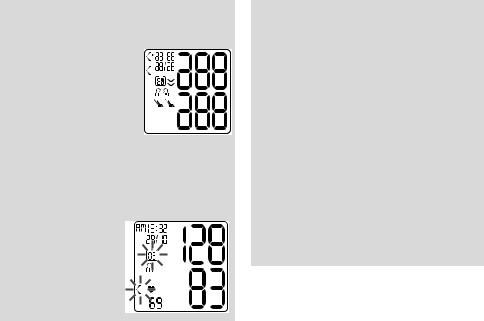
6.4Performing the blood pressure measurement
Attach the cuff and maintain correct posture throughout the measurement.
• Press the START/STOP 
 button to start the mea-
button to start the mea- 
 surement. All segments
surement. All segments 
in the LCD Display will 

 appear briefly.
appear briefly. 
 Measurement will begin after
Measurement will begin after 



about three seconds.
The measurement is taken during the inflation phase.
•You can cancel the measurement at any time by pressing the START/STOP button.
As soon as a pulse is detected, the pulse symbol is displayed.
•The systolic pressure, diastolic pressure,
and pulse rate are displayed.
• appears if the measurement was not performed properly. Refer to the chapter on error messages/troubleshooting and then repeat the measurement.
appears if the measurement was not performed properly. Refer to the chapter on error messages/troubleshooting and then repeat the measurement.
•Select a user memory number by pressing the M1 or M2 button. If you do not select a user memory, the measurement is stored in the most recently used user memory. The active user memory symbol M1 or M2 appears in the LCD Display.
•Press the START/STOP button to switch off the wrist blood pressure monitor. The measurement is then stored in the selected user memory.
•The device will shut off after about three minutes if no buttons are pressed. The last measurement is still stored in the selected or most recently used user memory.
•Wait at least 5 minutes before taking another measurement.
21

6.5 Evaluating results
 WARNING:
WARNING:
•This product does not and is not intended to provide a medical diagnosis. Measurements results are for reference only. Self-diagno- sis and treatment, e.g. regarding medication, using measured results represent a risk for your health. Always consult with a licensed physician for determination of appropriate medication and dosage thereof. Follow the instructions of your physician or licensed healthcare provider. If you have or suspect that you have a medical problem, promptly consult your physician. If you have an emergency please call 911 immediately.
•Only a physician or a trained health care professional who is familiar with your medical history is able to accurately interpret your blood pressure measurements. Consult your physician before starting blood pressure monitoring.
•Please note that technically related measuring tolerances are possible. Please see section “10. Technical Specifications” for details.
•If you notice abnormal or suspicious variations in blood pressure measurements, consult your physician immediately.
NOTE:
•A single measurement does not provide an accurate indication of your true blood pressure. You need to take and record several readings over a period of time. Try to measure your blood pressure at the same time each day for consistency.
Irregular heartbeat
 WARNING:
WARNING:
•The ’irregular heartbeat’ function does not replace a cardiac examination, but may help to detect potential pulse irregularities at an early stage. Always consult your physician to determine what will be suitable for you.
•The ’irregular heartbeat’ function is not designed for diagnosing or treating an arrhythmic disorder. Arrhythmia can only be ascertained by a licensed physician.
22
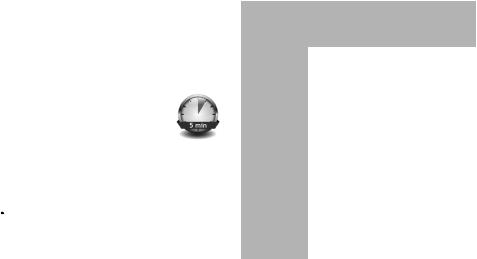
This device can identify potential disruptions of the heart rhythm when measuring by displaying the 
 symbol after a measurement.
symbol after a measurement.
This can be an indicator for arrhythmia, which is a condition in which the heart rhythm is abnormal. The symptoms (skipped or premature heartbeats, pulse being slow or too fast) can be caused by factors such as heart disease, age, physical makeup, excess stimulants, stress, or lack of sleep. Arrhythmia can only be determined by a doctor’s examination.
If the 
 symbol displays after a measurement, repeat the measurement after 5 minutes. Do not speak or move during measurement. If the symbol appears frequently, consult your doctor.
symbol displays after a measurement, repeat the measurement after 5 minutes. Do not speak or move during measurement. If the symbol appears frequently, consult your doctor.
Self-diagnosis and treatment based on these measurements can be dangerous. Always follow your doctor’s instructions.
 WARNING:
WARNING:
•The WHO chart is not intended to replace a medical diagnosis. This chart is only a reference for different classifications of blood pressure. According to WHO Guidelines/Defi-
nitions and the latest findings, the test results of adults can be classified and evaluated according to the following chart:
Blood pres- |
Systole |
Diastole |
|
|
sure value |
(in mmHg) |
(in mmHg) |
Action |
|
category |
|
|
|
|
Setting 3: |
|
|
seek medi- |
|
severe |
≥ 180 |
≥ 110 |
||
cal attention |
||||
hypertension |
|
|
||
|
|
|
||
Setting 2: |
|
|
seek medi- |
|
moderate |
160 – 179 |
100 – 109 |
||
cal attention |
||||
hypertension |
|
|
|
|
Setting 1: |
|
|
regular mon- |
|
mild |
140 – 159 |
90 – 99 |
itoring by |
|
hypertension |
|
|
doctor |
|
|
|
|
regular mon- |
|
High normal |
130 – 139 |
85 – 89 |
itoring by |
|
|
|
|
doctor |
|
Normal |
120 – 129 |
80 – 84 |
self- |
|
monitoring |
||||
|
|
|
||
Optimal |
< 120 |
< 80 |
self- |
|
monitoring |
||||
|
|
|
||
Source: WHO, 1999 (World Health Organization) |
|
|||
23

Measurement classification
In accordance with the guidelines/definitions of the WHO and the latest findings, measurements can be classified and assessed according to the following table.
These standard values serve only as a general guideline, as the individual blood pressure varies in different people and different age groups, etc.
Consult your doctor regularly for advice. Your doctor will tell you your normal blood pressure as well as the value above which your blood pressure is classified as dangerous.
The bar chart on the display and the scale on the unit show which category the recorded blood pressure values fall into. If the values of systolic and diastolic fall into two different categories (e.g. systolic in the high normal category and diastolic in the normal category), the classification on the device always shows the higher category; in this case high normal.
7.Displaying and deleting measurements
User memory
Every successful measurement is stored with the date and time. If there are more than 60 measurements, the oldest measurements are deleted.
•To access memory recall mode, press the M1 or M2 memory button to
|
select your desired user |
|
|
memory ( |
). |
• |
To view the measure- |
|
|
ments for user memory |
|
|
1, press M1. |
|
• |
To view the measure- |
|
|
ments for user memory |
|
|
2, press M2. |
|
The last measurement will appear on the LCD Display.
24

Average values
•Press M1 or M2 as desired.
A flashes on the display.
The average of all saved measurements for this user memory is displayed.
• Press M1 or M2 again. AM flashes on the display.
The average value of morning measurements for the last seven
days is displayed (5.00 AM – 9.00 AM).
• Press M1 or M2 again. PM flashes on the display.
The average value of evening measurements for the
last seven days is displayed (6.00 PM – 8.00 PM).
Individual measured values
• Press M1 or M2 again to display the last individual measurement (in this example, measurement 03).
• Press M1 or M2 again to view individual measurements.
•To switch the device off,
press the START/STOP button .
.
You can exit the menu at any time by pressing the START/STOP button .
.
Deleting measured values
•To clear the memory of the relevant user memory, first select a user memory.
•Access an individual measurement as described above.
•Press and hold both the
M1 and M2 buttons for
5 seconds.
CL and 00 appear on the LCD Display.
25

All the values in the current user memory are deleted. The device will then shut off.
8. Error messages/troubleshooting
If an error occurs, an “E” appears on the LCD Display followed by a number from 1 to 6.
Error messages are as follows:
•E1 - No pulse recorded
•E2 - Movement or speaking detected during measurement
•E3 - Cuff too tight or too loose
•E4 - Measurement error
•E5 - Inflation pressure higher than 300 mmHg
•E6 - Battery power low; replace batteries
If an error indicator appears, address the cause and then repeat the measurement.
9.Care, maintenance and storing the instrument
 WARNING:
WARNING:
•Do not use any cuffs, tubes, parts and accessories other than those explicitly recommended by the manufacturer for use with this
product. Parts and accessories not approved for use with the device may cause damage to your health and to the product.
 CAUTION:
CAUTION:
•Do not disassemble the unit, it may result in injuries.
•Clean your wrist blood pressure monitor carefully using a slightly damp cloth.
•Do not use any cleaning agents or solvents.
•Under no circumstances should you hold the unit under water, as this can cause liquid to enter and damage the unit.
•Never place any heavy objects on the device.
NOTICE:
•The blood pressure monitor is made up of precision electronic components. Accuracy of readings and the instrument’s service life depend on careful handling. Protect the unit against hard knocks (e.g. dropping the unit), moisture, water, dirt, dust, chemicals, extreme hot or cold temperatures, major temperature fluctuations, direct exposure to sunlight and heat sources which are
26
too close (e.g. stoves, heating radiators). This may damage the unit. The device must be stored in the specified ambient conditions. Please see section “8. Care, maintenance and storing the instrument” and section “10. Technical Specifications” for details.
•Do not use any aggressive solvents, cleaning agents, detergents or any other strong chemicals to clean the device.
•Never immerse and or spill water or any other liquid onto the monitor or any components, otherwise liquid will enter it and cause damage.
•Do not wash the unit in a washing machine, dish washer or tumble dryer.
•Observe the local regulations for material disposal. Dispose of the device, components and optional accessories according to applicable local regulations. Unlawful disposal may cause environmental pollution.
•Batteries can contain toxins that are harmful to the environment. Always dispose of batteries in accordance with applicable local regulations.
•Never attempt to repair, open and/or disassemble the unit or adjust it yourself. This may damage the unit and impair the functions. If you need to have
the unit repaired, please contact our customer service. Please see warranty for service contact. Before submitting any complaint, first check the batteries and replace them if necessary.
•Changes or modifications to the device will nullify the user warranty.
•Do not drop or insert any object into any opening or hose. This may damage the unit.
•Do not press the buttons with excessive force or with pointed objects.
•The monitor can maintain the safety and performance characteristics for a minimum of 10.000 measurements or 3 years
NOTE:
•Further documents which include information for the Calibration of the device can be asked at the service address.
•The device can be tested in case of supposed inaccuracy every two years. Please contact the nearest service address.
10. FCC/IC Statement
Changes or modifications to the product not expressly approved by the party responsible for com-
27
pliance could void the user’s authority to operate the equipment.
This equipment has been tested and found to comply with the limits for a Class B digital device, pursuant to Part 15 of the FCC Rules. These limits are designed to provide reasonable protection against harmful interference in a residential installation. This equipment generates, uses and can radiate radio frequency energy and, if not installed and used in accordance with the instructions, may cause harmful interference to radio communications. However, there is no guarantee that interference will not occur in a particular installation. If this equipment does cause harmful interference to radio or television reception, which can be determined by turning the equipment off and on, the user is encouraged to try to correct the interference by one or more of the following measures:
•Reorient or relocate the receiving antenna.
•Increase the separation between the equipment and receiver.
•Connect the equipment into an outlet on a circuit different from that to which the receiver is connected.
•Consult the dealer or an experienced radio/TV technician for help.
11. Technical Specifications
Model no. |
BC 81 |
Type |
BC 80 |
Measurement |
Oscillometric, non-invasive blood |
method |
pressure measurement on the |
|
wrist |
Measurement |
Cuff pressure 0-300 mmHg, |
range |
Systolic 50-250 mmHg, |
|
Diastolic 30-200 mmHg, |
|
Pulse 40-180 beats/minute |
Display accuSystolic ± 3 mmHg, |
|
racy |
Diastolic ± 3 mmHg, |
|
Pulse ± 5 % of the value shown |
Measurement |
Max. permissible standard devi- |
accuracy |
ation according to clinical testing: |
|
Systolic 8 mmHg / |
|
Diastolic 8 mmHg |
Memory |
2 x 60 memory spaces |
Dimensions |
L 3.8” x W 2.7” x H 0.9” |
|
(L 9.7 cm x W 6.8 cm x H 2.2 cm) |
Weight |
Approximately 3.8 oz. (108 g) |
|
(without batteries) |
28
Cuff size |
5.3” to 9.1” (13.5 cm to 23 cm ) |
|||||||
(wrist circum- |
|
|
|
|
|
|
|
|
ference) |
|
|
|
|
|
|
|
|
Permissible |
+41 °F to +104 °F (+5 °C to +40 |
|||||||
operating |
°C), 15-93 % relative humidity |
|||||||
conditions |
(non-condensing) |
|||||||
Permissible |
-13 °F to +158 °F (-25 °C to +70 |
|||||||
storage |
°C), 10-93 % relative humidity, |
|||||||
conditions |
700-1050 hPa ambient pressure |
|||||||
Power supply |
2 x 1.5V |
|
|
|
|
|
|
AAA batteries |
|
|
|
|
|
||||
|
|
|
|
|
|
|||
Battery life |
For approx. 300 measurements, |
|||||||
|
depending on levels of blood |
|||||||
|
pressure and pump pressure |
|||||||
Accessories |
Instructions for use, Quick start |
|||||||
|
guide, 2 x 1.5V AAA batteries, |
|||||||
|
storage box, blood pressure |
|||||||
|
passport |
|
|
|||||
Classification |
Internal supply, IPX0, no AP |
|||||||
|
or APG, continuous operation, |
|||||||
|
application part type BF |
|||||||
•The accuracy of this wrist blood pressure monitor has been carefully checked and developed with regard to a long useful life. Precise instructions
for checking accuracy may be requested from customer service.
•This device is in line with European Standard EN 60601-1-2 and is subject to particular precautions with regard to electromagnetic compatibility (EMC). Please note that portable and mobile HF communication systems may interfere with this unit. More details can be requested from the stated Customer Services address or found at the end of the instructions for use.
•This device corresponds to the EU Medical Devices Directive 93/42/EEC, the German Medical Devices Act (Medizinproduktgesetz) and the standards EN 1060-1 (non-invasive sphygmomanometers, Part 1: General requirements), EN 1060-3 (non-invasive sphygmomanometers, Part 3: Supplementary requirements for electro-me- chanical blood pressure measuring systems) and IEC 80601-2-30 (Medical electrical equipment – Part 2-30: Particular requirements for the basic safety and essential performance of automated non-invasive sphygmomanometers).
•The accuracy of this blood pressure monitor has been carefully checked and developed with regard to a long useful life. If using the device for
29
commercial medical purposes, it must be regularly tested for accuracy by appropriate means. Precise instructions for checking accuracy may be requested from the service address.
12. Warranty
Limited Lifetime Warranty For Original Purchaser
Your Beurer Wrist Blood Pressure Monitor, Model BC81, batteries and any optional accessory, is warranted to be free from defects in materials and workmanship for the life of the product under normal conditions of intended use and service. This warranty extends only to the original retail purchaser and does not extend to retailers or subsequent owners.
We will, at our option, repair or replace the Beurer Wrist Blood Pressure Monitor, Model BC81, without additional charge, for any part or parts covered by these written warranties. No refunds will be given. Repair or replacement is our only responsibility and your only remedy under this written warranty.
If replacement parts for defective materials are not available, Beurer reserves the right to make product substitutions in lieu of repair or replacement.
For warranty service contact our customer service department at 1-800-536-0366 or at info@beurer. com to provide a description of the problem. If the problem is deemed to be within the scope of the limited lifetime warranty, you will be asked to mail the product at your costs in its original package with proof of purchase, your name, address and phone number. If the problem is not deemed to be within the scope of the limited lifetime warranty, we will provide a quotation for repair, respectively, replacement and return shipping fees.
This warranty does not cover damage caused by misuse or abuse; accident; the attachment of unauthorized accessories; alteration to the product; improper installation; misapplication; lack of reasonable care with respect to the product; unauthorized repairs or modifications; improper use of electrical/ power supply; old worn batteries; normal wear; loss of power; dropped product; malfunction or damage of an operating part as a result of failure to comply with instructions for use or to provide manufacturer’s recommended maintenance; transit damage; theft; neglect; vandalism; or environmental conditions; loss of use during the period the product is at a repair facility or otherwise awaiting parts or repair; or any
30
